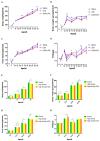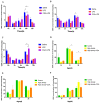Effect of Dietary Chlorogenic Acid on Growth Performance, Antioxidant Function, and Immune Response of Broiler Breeders under Immune Stress and Stocking Density Stress
- PMID: 36288195
- PMCID: PMC9611266
- DOI: 10.3390/vetsci9100582
Effect of Dietary Chlorogenic Acid on Growth Performance, Antioxidant Function, and Immune Response of Broiler Breeders under Immune Stress and Stocking Density Stress
Abstract
The study was conducted to evaluate the effects of dietary chlorogenic acid supplementation on the growth performance, antioxidant function, and immune response of broiler breeders exposed to immune stress or high stocking density stress. The test was divided into two stress models. For the immune stress test, 198 birds were distributed into three experimental treatments with six replicates per treatment. The treatments were: (1) saline control (birds injected with saline and fed basal diet), (2) LPS group (birds injected with 0.5 mg LPS/kg body weight and fed basal diet), and (3) CGA + LPS group (birds injected with LPS and fed basal diet supplemented with 1 g/kg CGA. LPS was intraperitoneally injected from day 14, and then daily for 10 days. For the high stocking density stress model, 174 birds were distributed into three experimental treatments with six replicates per treatment. The treatments were: (1) controls (birds fed basal diet and raised at a stocking density of 14 broilers per m2), (2) high-density group (birds fed with basal diet and raised at a stocking density of 22 broilers per m2), and (3) high density + CGA group (birds fed with 1 g/kg CGA and raised at a stocking density of 22 broilers per m2). Results showed that LPS injection and high stocking density significantly decreased the body weight and feed intake of broiler breeders, while CGA supplementation increased feed intake of broiler breeders under LPS injection and high stocking density stress. Moreover, LPS injection and high stocking density increased the concentration of corticosterone in serum, and CGA addition remarkably downregulated serum corticosterone levels. The GSH level decreased with LPS injection and CGA increased the GSH concentration in the intestines of immune-stressed broiler breeders. LPS injection promoted the production of circulating proinflammatory cytokines (serum IL-1β and TNF-α) by 72 h after LPS injection. Dietary supplementation with CGA prevented the increase in serum TNF-α caused by LPS. These results suggest that dietary inclusion of 1 g/kg CGA could increase the feed intake of broiler breeders and alleviate the effects of inflammatory mediator stress and exposure to high stocking density.
Keywords: anti-inflammatory; antioxidant; chlorogenic acid; growth performance; stress.
Conflict of interest statement
The authors declare no conflict of interest.
Figures





References
Grants and funding
LinkOut - more resources
Full Text Sources
Research Materials

